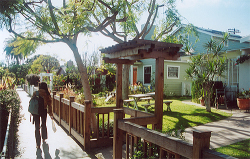What does sustainable look like?
When we speak of sustainable living on this blog, we’re not talking about using the politically correct CFL bulbs or buying a Prius. That much should be obvious by now.
It’s okay here to acknowledge things that are taboo in the politically correct world. That’s the only way to have meaningful discourse. So, what is “sustainable” as it pertains to lifestyle?
There are a couple different methods of getting there, and Brett has already discussed that a society based on culture rather than consumerism is the first big step. But once there, what can a sustainable society look like beyond the strong leadership and cultural bond?Â
Here are some things I’d expect to see in smaller, nationalist communities.
-
Population: First and foremost, any sustainable human society needs to keep its numbers in check. While it’s comfortable for us to shut ourselves into sheet-rocked houses and forget that there’s a natural world out there, we should follow nature’s guiding principles that any overpopulated society eventually runs out of resources, and dies slowly over time or in a blaze of glory through
 natural disaster. Limiting human population voluntarily would be a monumental achievement on the part of our species.
natural disaster. Limiting human population voluntarily would be a monumental achievement on the part of our species.But realistically, it won’t happen worldwide, certainly not all at once. The best we can do is create strong nations which limit or eliminate immigration while simultaneously keeping their own population in check. Unfortunately, this is very difficult to do with our current globalist trend – import cheap labor when population growth plateaus, to keep the cheap labor and cheap resources flowing in the name of growth (= more money in the hands of end-users, who make short-sighted purchases that don’t help the economy). It can’t last, of course, but no one cares about the inevitable brick wall that awaits just beyond the horizon. That attitude needs to change.
-
Smaller communities: There are many areas, particularly as you get further west in the States, which have large swaths of land dedicated to only a few homes. While this seems good at first glance, it makes it impossible to live in these areas without having a car and cheap gas to get you from points A to B. But we also don’t want large, stuffy, concrete urban centers.
If people who lived in spread-out areas clustered together, but preserved as much of the natural landscape as possible in their immediate surroundings, the footprint of humanity in those areas would be reduced immensely.
 Most suburbs should look to solutions like New Pedestrianism, which limits the use of motorized vehicles and favors walking and cycling.
Most suburbs should look to solutions like New Pedestrianism, which limits the use of motorized vehicles and favors walking and cycling. -
Resource usage: Measures should be taken to not only limit unnecessary usage of nonrenewable energy sources, but also to find new and better ways to harness energy. But only in the context of stronger culture and the other factors listed here will this cease to be a problem.No one here is advocating moving back into caves and using only natural light.But take modern kitchens: lighting has become an elective luxury – flood lights everywhere, under-cabinet lighting, track lighting, etc.
Just because it’s fluorescent and more efficient, doesn’t mean using more and more of it is appropriate, but that’s a product of modern society. If it uses less energy, the thinking goes, you can – and should – use more of it and it’s okay. This does little to change consumerism as the driving force in a society. It’s just as much about our attitude toward resources as the method in which they’re used.
-
Self-supporting culture and economy: This seems obvious, and is more a goal than a method. But it’s not stated often enough: globalism will kill off any real culture and replace it with lowest common denominator politics and materialism. The best way for culture to survive is to be as self-reliant as possible with as little trade and population influx from other nations as possible.









